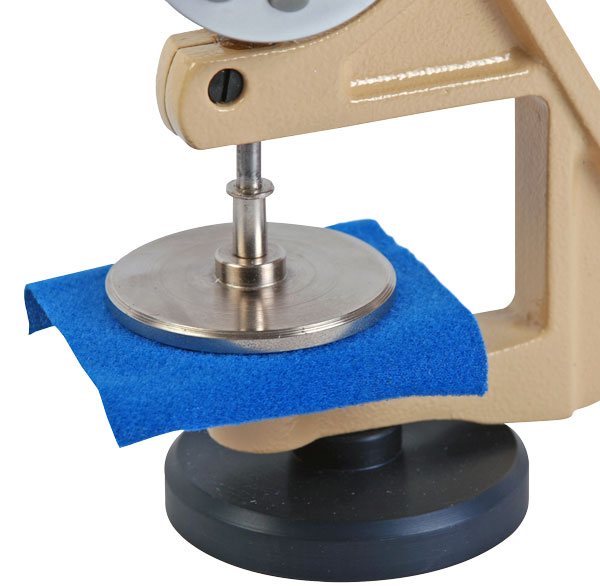Understanding the nonwoven thickness gauge: A Comprehensive Guide
Nonwoven thickness gauges are specialized instruments used to measure the thickness of nonwoven fabrics. Nonwovens are engineered fabrics that are made by bonding or interlocking fibers together through various processes like mechanical, thermal, or chemical methods, rather than traditional weaving or knitting techniques. Measuring the thickness of nonwoven fabrics is important for quality control, product development, and ensuring compliance with industry standards. In this comprehensive guide, we will explore the key aspects of nonwoven thickness gauges, including their principles of operation, types, usage considerations, and benefits.

Principles of Operation:
Nonwoven thickness gauges operate based on different principles, but the most common methods include:
Mechanical Thickness Gauges: These gauges employ mechanical means to measure the thickness of nonwoven fabrics. They typically consist of an anvil and a measuring head. The fabric is placed between the anvil and the measuring head, and the gauge applies a specific pressure to determine the thickness by measuring the compression of the fabric.
Ultrasonic Thickness Gauges: Ultrasonic thickness gauges use ultrasonic waves to measure the thickness of nonwoven fabrics. The gauge emits high-frequency sound waves that travel through the fabric and are reflected back. By measuring the time taken for the waves to travel through the fabric and return, the gauge calculates the fabric's thickness.
Optical Thickness Gauges: Optical gauges use optical sensors to measure the thickness of nonwoven fabrics. They employ techniques such as laser triangulation or optical interference to determine the distance between the sensor and the fabric surface, allowing for thickness measurement.
Types of Nonwoven Thickness Gauges:
Nonwoven thickness gauges are available in various types to suit different applications. Some common types include:
Handheld Gauges: Handheld gauges are portable and easy to use. They are suitable for quick measurements on the production floor or in the field. These gauges often feature digital displays and simple controls.
Benchtop Gauges: Benchtop gauges are larger and more sophisticated instruments designed for precise and accurate measurements. They offer advanced features such as data logging, statistical analysis, and customizable settings.
Online Gauges: Online gauges are integrated into production lines and provide real-time thickness measurements during the manufacturing process. They enable continuous monitoring and adjustment, ensuring consistent product quality.
Usage Considerations:
When using a nonwoven thickness gauge, consider the following factors:
Measurement Technique: Ensure that the chosen gauge's measurement principle aligns with your specific requirements, such as accuracy, speed, and ease of use.
Calibration and Accuracy: Regular calibration is essential to maintain measurement accuracy. Follow the manufacturer's guidelines for calibration procedures and frequency.
Sample Preparation: Prepare the nonwoven fabric samples according to the gauge's specifications. Ensure that the samples are representative of the material being measured and are flat and free from wrinkles or folds.
Measurement Location: Determine the appropriate locations on the fabric for measurement. Consider factors such as fabric variability and the purpose of the measurements (e.g., edge measurements, center measurements, or multiple points across the fabric).
Measurement Units: Ensure that the gauge is set to the desired measurement units (e.g., millimeters, micrometers, or inches) for consistency and ease of interpretation.
Benefits of Nonwoven Thickness Gauges:
Nonwoven thickness gauges offer several benefits, including:
Quality Control: Gauging the thickness of nonwoven fabrics helps ensure consistent product quality and adherence to industry standards. It enables manufacturers to identify variations in thickness that may affect performance or functionality.
Process Optimization: Continuous thickness monitoring with online gauges allows for real-time process adjustments, minimizing material waste and improving production efficiency.
Product Development: Thickness measurements aid in product development, enabling manufacturers to optimize material selection, process parameters, and design features to meet specific performance targets.
Compliance and Certification: Nonwoven thickness measurements are often required to comply with industry standards and certifications. Gauging helps ensure that materials meet the specified thickness requirements for safety, performance, or regulatory compliance.
In conclusion, nonwoven thickness gauges play a crucial role in the nonwoven fabric industry by providing accurate and reliable measurements. Understanding the principles of operation, types, usage considerations, and benefits of these gauges can assist in effectively utilizing them for quality control, process optimization, and product development in the nonwoven manufacturing process.

